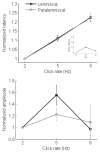A possible role for a paralemniscal auditory pathway in the coding of slow temporal information
- PMID: 21094680
- PMCID: PMC3039065
- DOI: 10.1016/j.heares.2010.10.009
A possible role for a paralemniscal auditory pathway in the coding of slow temporal information
Abstract
Low-frequency temporal information present in speech is critical for normal perception, however the neural mechanism underlying the differentiation of slow rates in acoustic signals is not known. Data from the rat trigeminal system suggest that the paralemniscal pathway may be specifically tuned to code low-frequency temporal information. We tested whether this phenomenon occurs in the auditory system by measuring the representation of temporal rate in lemniscal and paralemniscal auditory thalamus and cortex in guinea pig. Similar to the trigeminal system, responses measured in auditory thalamus indicate that slow rates are differentially represented in a paralemniscal pathway. In cortex, both lemniscal and paralemniscal neurons indicated sensitivity to slow rates. We speculate that a paralemniscal pathway in the auditory system may be specifically tuned to code low-frequency temporal information present in acoustic signals. These data suggest that somatosensory and auditory modalities have parallel sub-cortical pathways that separately process slow rates and the spatial representation of the sensory periphery.
Copyright © 2010 Elsevier B.V. All rights reserved.
Figures







Similar articles
-
Auditory Thalamostriatal and Corticostriatal Pathways Convey Complementary Information about Sound Features.J Neurosci. 2019 Jan 9;39(2):271-280. doi: 10.1523/JNEUROSCI.1188-18.2018. Epub 2018 Nov 20. J Neurosci. 2019. PMID: 30459227 Free PMC article.
-
Neural coding of temporal information in auditory thalamus and cortex.Neuroscience. 2008 Nov 19;157(2):484-94. doi: 10.1016/j.neuroscience.2008.07.050. Neuroscience. 2008. PMID: 19143093 Review.
-
Neural coding of temporal information in auditory thalamus and cortex.Neuroscience. 2008 Jun 12;154(1):294-303. doi: 10.1016/j.neuroscience.2008.03.065. Epub 2008 Apr 7. Neuroscience. 2008. Corrected and republished in: Neuroscience. 2008 Nov 19;157(2):484-94. doi: 10.1016/j.neuroscience.2008.07.050. PMID: 18555164 Free PMC article. Corrected and republished. Review.
-
Slow oscillation in non-lemniscal auditory thalamus.J Neurosci. 2003 Sep 10;23(23):8281-90. doi: 10.1523/JNEUROSCI.23-23-08281.2003. J Neurosci. 2003. PMID: 12967990 Free PMC article.
-
Frequency selectivity is related to temporal processing in parallel thalamocortical auditory pathways.Brain Res. 1992 Jun 26;583(1-2):81-92. doi: 10.1016/s0006-8993(10)80011-3. Brain Res. 1992. PMID: 1504845
Cited by
-
Bilateral projections to the thalamus from individual neurons in the inferior colliculus.J Comp Neurol. 2019 Apr 15;527(6):1118-1126. doi: 10.1002/cne.24600. Epub 2018 Dec 30. J Comp Neurol. 2019. PMID: 30536721 Free PMC article.
-
Properties of the thalamic projection from the posterior medial nucleus to primary and secondary somatosensory cortices in the mouse.Proc Natl Acad Sci U S A. 2011 Nov 1;108(44):18156-61. doi: 10.1073/pnas.1114828108. Epub 2011 Oct 24. Proc Natl Acad Sci U S A. 2011. PMID: 22025694 Free PMC article.
-
The organization and physiology of the auditory thalamus and its role in processing acoustic features important for speech perception.Brain Lang. 2013 Jul;126(1):29-48. doi: 10.1016/j.bandl.2013.03.003. Brain Lang. 2013. PMID: 23725661 Free PMC article. Review.
-
Thalamocortical mechanisms for integrating musical tone and rhythm.Hear Res. 2014 Feb;308:50-9. doi: 10.1016/j.heares.2013.09.017. Epub 2013 Oct 6. Hear Res. 2014. PMID: 24103509 Free PMC article. Review.
-
Presynaptic Neuronal Nicotinic Receptors Differentially Shape Select Inputs to Auditory Thalamus and Are Negatively Impacted by Aging.J Neurosci. 2017 Nov 22;37(47):11377-11389. doi: 10.1523/JNEUROSCI.1795-17.2017. Epub 2017 Oct 23. J Neurosci. 2017. PMID: 29061702 Free PMC article.
References
-
- Ahissar E, Zacksenhouse M. Temporal and spatial coding in the rat vibrissal system. Prog Brain Res. 2001;130:75–87. - PubMed
-
- Ahissar E, Sosnik R, Haidarliu S. Transformation from temporal to rate coding in a somatosensory thalamocortical pathway. Nature. 2000;406:302–6. - PubMed
-
- Anderson SE, Kilgard MP, Sloan AM, Rennaker RL. Response to broadband repetitive stimuli in auditory cortex of the unanesthetized rat. Hear Res. 2006;213:107–17. - PubMed
Publication types
MeSH terms
Grants and funding
LinkOut - more resources
Full Text Sources

